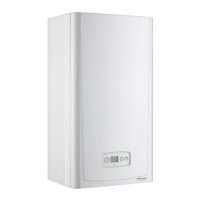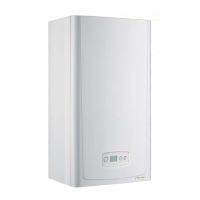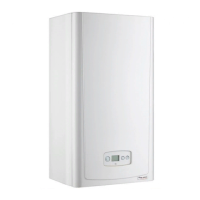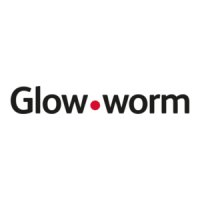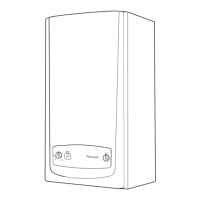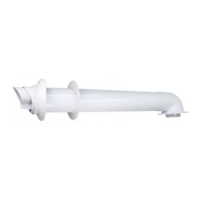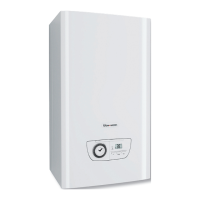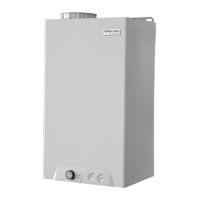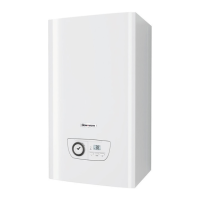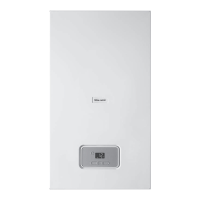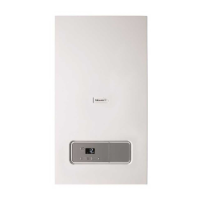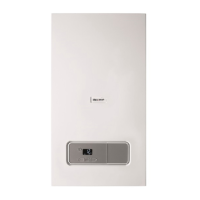6
Boiler Design
Boiler Design
These boilers are designed for use as part of a sealed water
central heating system with fully pumped circulation. The
pump, expansion vessel and associated safety devices are all
tted within the boiler. The daily pump exercise programme
combined with the built-in frost protection will help to maintain
and protect the boiler. Once the controls are set the boiler
operates automatically.
Range Rating
The boilers are fully modulating, it is therefore not necessary
to range rate them. However, if desired, it is possible to range
rate the boiler between 10 and Max. output (according to the
model), in 1kW increments, refer to section 12.
Electrical Supply Failure
The boiler will not work without an electrical supply.
Normal operation of the boiler should resume when the
electrical supply is restored. Reset any external controls, to
resume normal operation of the central heating. If the boiler
does not resume normal operation press the reset button. If
the boiler does not resume normal operation after this call
your Installation/Servicing company or Glow-worm service.
Overheating Safety
The boiler software is designed to recognise the potential
for an overheat lockout and will shutdown before this
happens. To restart the boiler, press the reset button on the
controls fascia. If the boiler fails to resume normal operation
and all external controls are calling for heat, then call your
Installation/Servicing company or Glow-worm service.
Safety Discharge Valve
A safety discharge valve and discharge pipe are tted to the
boiler. This valve must not be interfered with, should there
be any discharge from the pipe, isolate the boiler electrical
supply and call your installer or Glow-worm’s own service
organisation using the telephone number on the inside front
cover of this booklet.
Safety Devices
Frost protection
The appliance has a built in frost protection device that
protects the boiler from freezing. With the gas and electric
supplies ON and irrespective of any room thermostat setting,
the frost protection device will operate the pump when the
temperature of the boiler water falls below 8°C.
A timer is used so that the temperature can be checked
periodically. After 10 minutes the pump will be stopped if the
temperature is higher than 10°C or has already reached 35°C.
The burner will activate if the boiler temperature does not
reach 10°C after 30 minutes or at any time if the temperature
drops to 5°C.
The burner will switch off when the temperature reaches 35°C.
Condensate Drain Blockage
As a safety feature the boiler will stop working if the
condensate drain becomes blocked. During freezing
conditions an ice blockage in the condense drain, external to
the house would also activate the safety feature. Use warm
cloths on the pipe to release an ice blockage.
Once the blockage is removed the boiler should then restart.
Condensate Drain
A plastic drain pipe must be tted to allow discharge of
condensate to a drain. Condensate should, if possible, be
discharged into the internal household draining system. If
this is not practical, discharge can be made externally into
the household drainage system or a purpose designed soak
away, see section 8 for more details.
Pluming from ue terminal
Like all condensing boilers this appliance will produce a plume
of condensation from the ue terminal in cool weather. This is
due to the high efciency and hence low ue gas temperature
of the boiler. This is normal and not an indication of a fault.
Servicing, Maintenance and Spare Parts
Servicing and Maintenance
To ensure the continued efcient and safe operation of the
boiler it is recommended that it is checked and serviced as
necessary at regular intervals. The frequency of servicing will
depend upon the particular installation conditions and usage.
If this applaince is installed in a rented property there is a duty
of care imposed on the owner of the property by the current
issue of the Gas Safety (Installation and Use) Regulations,
Section 35.
Servicing/maintenance should be carried out by a competent
person approved at the time by the Health and Safety
Executive in accordance with the rules in force in the
countries of destination.
To obtain service, please call your installer or Glow-worm’s
own service organisation using the telephone number on the
inside front cover of this literature.
Spare Parts
We only use parts that you can be assured conform to
the safety and performance specication. DO NOT use
reconditioned or copy parts that have not been clearly
authorised by Glow-worm.
If a part is required contact Glow-worm’s own service
organisation using the telephone number on the inside front
cover of this booklet.
Please quote the name of the appliance, this information will
be on the name badge on the front of the appliance.
If in doubt seek advice from the local gas company or Glow-
worm’s own service organisation using the telephone number
on the inside front cover of this booklet.
